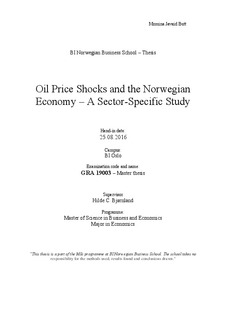| dc.contributor.author | Butt, Momina Javaid | |
| dc.date.accessioned | 2017-06-06T11:55:28Z | |
| dc.date.available | 2017-06-06T11:55:28Z | |
| dc.date.issued | 2016 | |
| dc.identifier.uri | http://hdl.handle.net/11250/2444438 | |
| dc.description | Masteroppgave(MSc) in Master of Science in Business, Economics - Handelshøyskolen BI, 2016 | nb_NO |
| dc.description.abstract | In this paper, I compare the macroeconomic consequences of two types of oil price shocks on different sectors in Norway by the use of a Structural Autoregressive (SVAR) model. The two structural shocks are each identified as global demand shock and oil-specific shock, which is the decomposition of the real oil price proposed by Kilian (2009). Economic activity is measured by changes in sector-specific gross domestic product (GDP), employment and real wage. Based on input-output analysis, the sectors discussed in the paper have the closest linkage to the petroleum industry and are very much likely to be effected by a shift in the oil price. The result crucially depends on the underlying sources of the oil price change, in terms of the magnitude and the persistence of the responses. One of the main findings is that the oil-specific shock appears to be the most important shock for all the sectors. This result is robust for monetary policy adjustments. In addition, asymmetry tests were applied to check for potential non-linearity and asymmetry in the relationship between the real oil price and Norwegian macroeconomic variables. However, findings suggests that there is symmetry and linearity in the relationship. | nb_NO |
| dc.language.iso | eng | nb_NO |
| dc.publisher | BI Norwegian Business School | nb_NO |
| dc.subject | samfunnsøkonomi | nb_NO |
| dc.subject | economics | nb_NO |
| dc.title | Oil Price Shocks and the Norwegian Economy ; A Sector-Specific Study | nb_NO |
| dc.type | Master thesis | nb_NO |
